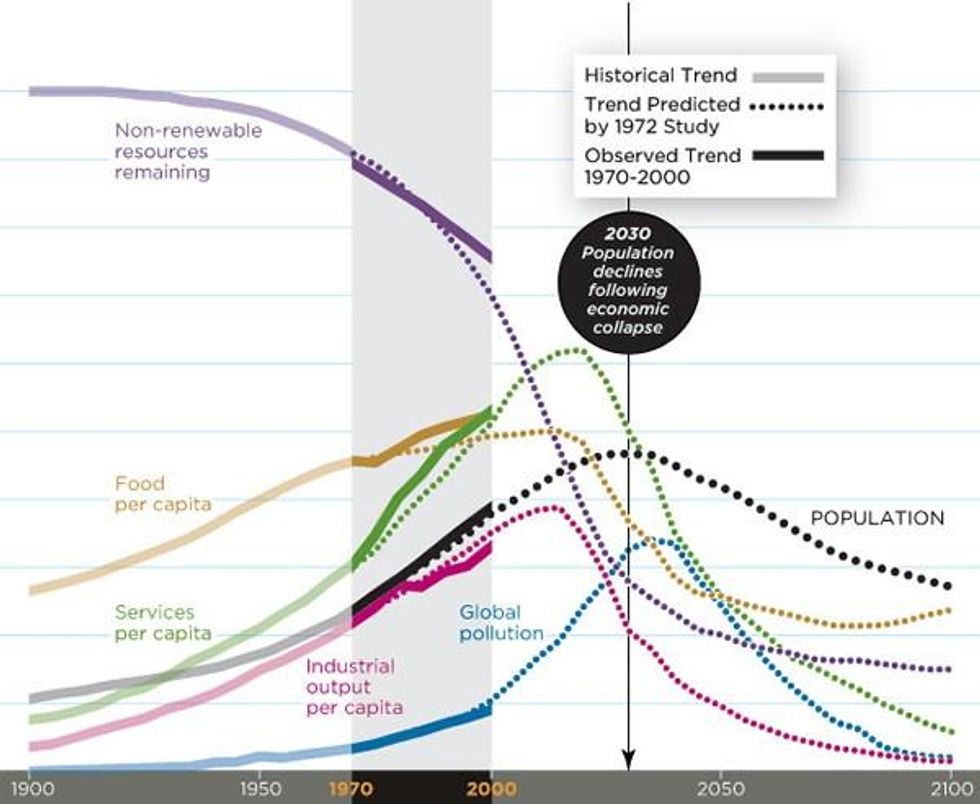Limits to Growth: 1972 'Collapse' Prediction Still on Track
A renowned Australian research scientist has expressed concern over a possible "global economic collapse" that may occur in 2030 if humans fail to check expansion and preserve the world's already diminishing resources.
Physicist Graham Turner says the 1972 MIT study --"The Limits to Growth" -- claiming the world could suffer from a "global economic collapse" and "precipitous population decline" if people continue to consume the world's resources at the current pace is still on track, nearly 40 years after it was first produced.
The new issue of Smithsonian Magazine writes that Australian physicist Graham Turner, who works at the CSIRO Sustainable Ecosystems, says "the world is on track for disaster" and that current research from Turner coincides with the 1972 MIT study.
"The business-as-usual scenario estimated that if human beings continued to consume more than nature was capable of providing, global economic collapse and precipitous population decline could occur by 2030."
The study created a computing model to forecast different scenarios based on the current models of population growth and global resource consumption. The study also took into account different levels of agricultural productivity, birth control and environmental protection efforts. Over twelve million copies of the 1972 report were sold and distributed in at least 37 different languages.
Turner says that perhaps the most startling find from his current research is that the real world data since 1972 were nearly identical to those predicted in similar computer models used 40-years ago as the basis for "The Limits to Growth."
"There is a very clear warning bell being rung here," Turner said. "We are not on a sustainable trajectory."
* * *
The Smithsonian Magazine reports:
Looking Back on the Limits of Growth
Recent research supports the conclusions of a controversial environmental study released 40 years ago: The world is on track for disaster. So says Australian physicist Graham Turner, who revisited perhaps the most groundbreaking academic work of the 1970s, The Limits to Growth.
"There is a very clear warning bell being rung here. We are not on a sustainable trajectory."Written by MIT researchers for an international think tank, the Club of Rome, the study used computers to model several possible future scenarios. The business-as-usual scenario estimated that if human beings continued to consume more than nature was capable of providing, global economic collapse and precipitous population decline could occur by 2030.
However, the study also noted that unlimited economic growth was possible, if governments forged policies and invested in technologies to regulate the expansion of humanity's ecological footprint. Prominent economists disagreed with the report's methodology and conclusions. Yale's Henry Wallich opposed active intervention, declaring that limiting economic growth too soon would be "consigning billions to permanent poverty."
Turner compared real-world data from 1970 to 2000 with the business-as-usual scenario. He found the predictions nearly matched the facts. "There is a very clear warning bell being rung here," he says. "We are not on a sustainable trajectory."
* * *

# # #
An Urgent Message From Our Co-Founder
Dear Common Dreams reader, The U.S. is on a fast track to authoritarianism like nothing I've ever seen. Meanwhile, corporate news outlets are utterly capitulating to Trump, twisting their coverage to avoid drawing his ire while lining up to stuff cash in his pockets. That's why I believe that Common Dreams is doing the best and most consequential reporting that we've ever done. Our small but mighty team is a progressive reporting powerhouse, covering the news every day that the corporate media never will. Our mission has always been simple: To inform. To inspire. And to ignite change for the common good. Now here's the key piece that I want all our readers to understand: None of this would be possible without your financial support. That's not just some fundraising cliche. It's the absolute and literal truth. We don't accept corporate advertising and never will. We don't have a paywall because we don't think people should be blocked from critical news based on their ability to pay. Everything we do is funded by the donations of readers like you. Will you donate now to help power the nonprofit, independent reporting of Common Dreams? Thank you for being a vital member of our community. Together, we can keep independent journalism alive when it’s needed most. - Craig Brown, Co-founder |
A renowned Australian research scientist has expressed concern over a possible "global economic collapse" that may occur in 2030 if humans fail to check expansion and preserve the world's already diminishing resources.
Physicist Graham Turner says the 1972 MIT study --"The Limits to Growth" -- claiming the world could suffer from a "global economic collapse" and "precipitous population decline" if people continue to consume the world's resources at the current pace is still on track, nearly 40 years after it was first produced.
The new issue of Smithsonian Magazine writes that Australian physicist Graham Turner, who works at the CSIRO Sustainable Ecosystems, says "the world is on track for disaster" and that current research from Turner coincides with the 1972 MIT study.
"The business-as-usual scenario estimated that if human beings continued to consume more than nature was capable of providing, global economic collapse and precipitous population decline could occur by 2030."
The study created a computing model to forecast different scenarios based on the current models of population growth and global resource consumption. The study also took into account different levels of agricultural productivity, birth control and environmental protection efforts. Over twelve million copies of the 1972 report were sold and distributed in at least 37 different languages.
Turner says that perhaps the most startling find from his current research is that the real world data since 1972 were nearly identical to those predicted in similar computer models used 40-years ago as the basis for "The Limits to Growth."
"There is a very clear warning bell being rung here," Turner said. "We are not on a sustainable trajectory."
* * *
The Smithsonian Magazine reports:
Looking Back on the Limits of Growth
Recent research supports the conclusions of a controversial environmental study released 40 years ago: The world is on track for disaster. So says Australian physicist Graham Turner, who revisited perhaps the most groundbreaking academic work of the 1970s, The Limits to Growth.
"There is a very clear warning bell being rung here. We are not on a sustainable trajectory."Written by MIT researchers for an international think tank, the Club of Rome, the study used computers to model several possible future scenarios. The business-as-usual scenario estimated that if human beings continued to consume more than nature was capable of providing, global economic collapse and precipitous population decline could occur by 2030.
However, the study also noted that unlimited economic growth was possible, if governments forged policies and invested in technologies to regulate the expansion of humanity's ecological footprint. Prominent economists disagreed with the report's methodology and conclusions. Yale's Henry Wallich opposed active intervention, declaring that limiting economic growth too soon would be "consigning billions to permanent poverty."
Turner compared real-world data from 1970 to 2000 with the business-as-usual scenario. He found the predictions nearly matched the facts. "There is a very clear warning bell being rung here," he says. "We are not on a sustainable trajectory."
* * *

# # #
A renowned Australian research scientist has expressed concern over a possible "global economic collapse" that may occur in 2030 if humans fail to check expansion and preserve the world's already diminishing resources.
Physicist Graham Turner says the 1972 MIT study --"The Limits to Growth" -- claiming the world could suffer from a "global economic collapse" and "precipitous population decline" if people continue to consume the world's resources at the current pace is still on track, nearly 40 years after it was first produced.
The new issue of Smithsonian Magazine writes that Australian physicist Graham Turner, who works at the CSIRO Sustainable Ecosystems, says "the world is on track for disaster" and that current research from Turner coincides with the 1972 MIT study.
"The business-as-usual scenario estimated that if human beings continued to consume more than nature was capable of providing, global economic collapse and precipitous population decline could occur by 2030."
The study created a computing model to forecast different scenarios based on the current models of population growth and global resource consumption. The study also took into account different levels of agricultural productivity, birth control and environmental protection efforts. Over twelve million copies of the 1972 report were sold and distributed in at least 37 different languages.
Turner says that perhaps the most startling find from his current research is that the real world data since 1972 were nearly identical to those predicted in similar computer models used 40-years ago as the basis for "The Limits to Growth."
"There is a very clear warning bell being rung here," Turner said. "We are not on a sustainable trajectory."
* * *
The Smithsonian Magazine reports:
Looking Back on the Limits of Growth
Recent research supports the conclusions of a controversial environmental study released 40 years ago: The world is on track for disaster. So says Australian physicist Graham Turner, who revisited perhaps the most groundbreaking academic work of the 1970s, The Limits to Growth.
"There is a very clear warning bell being rung here. We are not on a sustainable trajectory."Written by MIT researchers for an international think tank, the Club of Rome, the study used computers to model several possible future scenarios. The business-as-usual scenario estimated that if human beings continued to consume more than nature was capable of providing, global economic collapse and precipitous population decline could occur by 2030.
However, the study also noted that unlimited economic growth was possible, if governments forged policies and invested in technologies to regulate the expansion of humanity's ecological footprint. Prominent economists disagreed with the report's methodology and conclusions. Yale's Henry Wallich opposed active intervention, declaring that limiting economic growth too soon would be "consigning billions to permanent poverty."
Turner compared real-world data from 1970 to 2000 with the business-as-usual scenario. He found the predictions nearly matched the facts. "There is a very clear warning bell being rung here," he says. "We are not on a sustainable trajectory."
* * *

# # #

